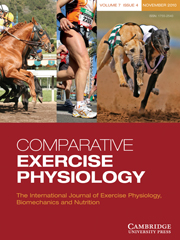Article contents
Post-exercise systolic blood pressure recovery and adiposity in adults
Published online by Cambridge University Press: 01 November 2010
Abstract
To determine the incidence of abnormal or delayed systolic blood pressure recovery (SBPR) in relation to the level of adiposity in the adult population; the risk of delayed SBPR in overweight/obese adults relative to their non-overweight/obese controls; and the best predictor of third-minute systolic blood pressure (SBP) ratio and delayed SBPR among four obesity indices – body mass index (BMI), waist circumference, waist-to-hip ratio (WHR) and waist-to-height ratio (WHtR). Two hundred and ninety-six apparently healthy adults aged 18–48 years participated in the study. Anthropometric variables were measured, and subjects performed cycle ergometer exercise at 80% age-predicted maximum heart rate. Blood pressure (BP) and heart rate were measured before and during exercise. BP was further measured immediately after exercise and subsequently at 2 min intervals until recovery to resting position. The incidence and risk of delayed SBPR were higher in the overweight/obese individuals than those in the non-overweight/obese controls. Multivariable regression analyses revealed that BMI in males and WHtR and WHR in females had the strongest relationships (P < 0.05) with post-exercise SBPR. WHtR and BMI had the strongest associations with increased risk of delayed SBPR in the non-overweight/obese and the overweight/obese individuals, respectively. The present findings suggest that WHtR in the non-obese individuals and BMI in the overweight/obese individuals may be the best obesity variables for the prediction of abnormal post-exercise SBP response. Our findings further suggest that a reduction in body weight through healthy activities such as exercise may reduce the incidence and increased risk of delayed SBPR and its associated cardiovascular risks.
Keywords
- Type
- Research Paper
- Information
- Copyright
- Copyright © Cambridge University Press 2010
References
- 1
- Cited by


